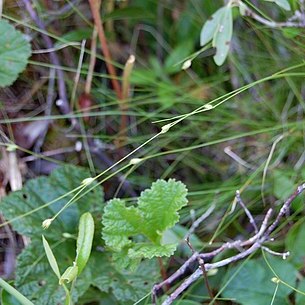Loosely tufted on short, slender rhizomes; stems very slender and weak, 2–7 dm; spikes (1)2(3), sessile, 1–4 cm apart in a slender, often flexuous infl, each with 1–5 perigynia and a few basal staminate fls; lowest spike subtended by a setaceous bract 2–4 cm; scales ovate, acute, hyaline with a green center, shorter than or about equaling the perigynia, these thickly planoconvex, oval, 2.6–4 mm, finely many-nerved, the slender, smooth, emarginate beak 0.5 mm; achene lenticular, oval-oblong, filling the perigynium; 2n=60. Typical plants have lvs 1–2 mm wide and usually 2–5 perigynia per spike. Plants from Nf. to Vt. and Pa., mostly near the coast, with setaceous lvs 0.5 mm wide, and with only 1 or 2 somewhat smaller perigynia, have been called var. billingsii Knight.


